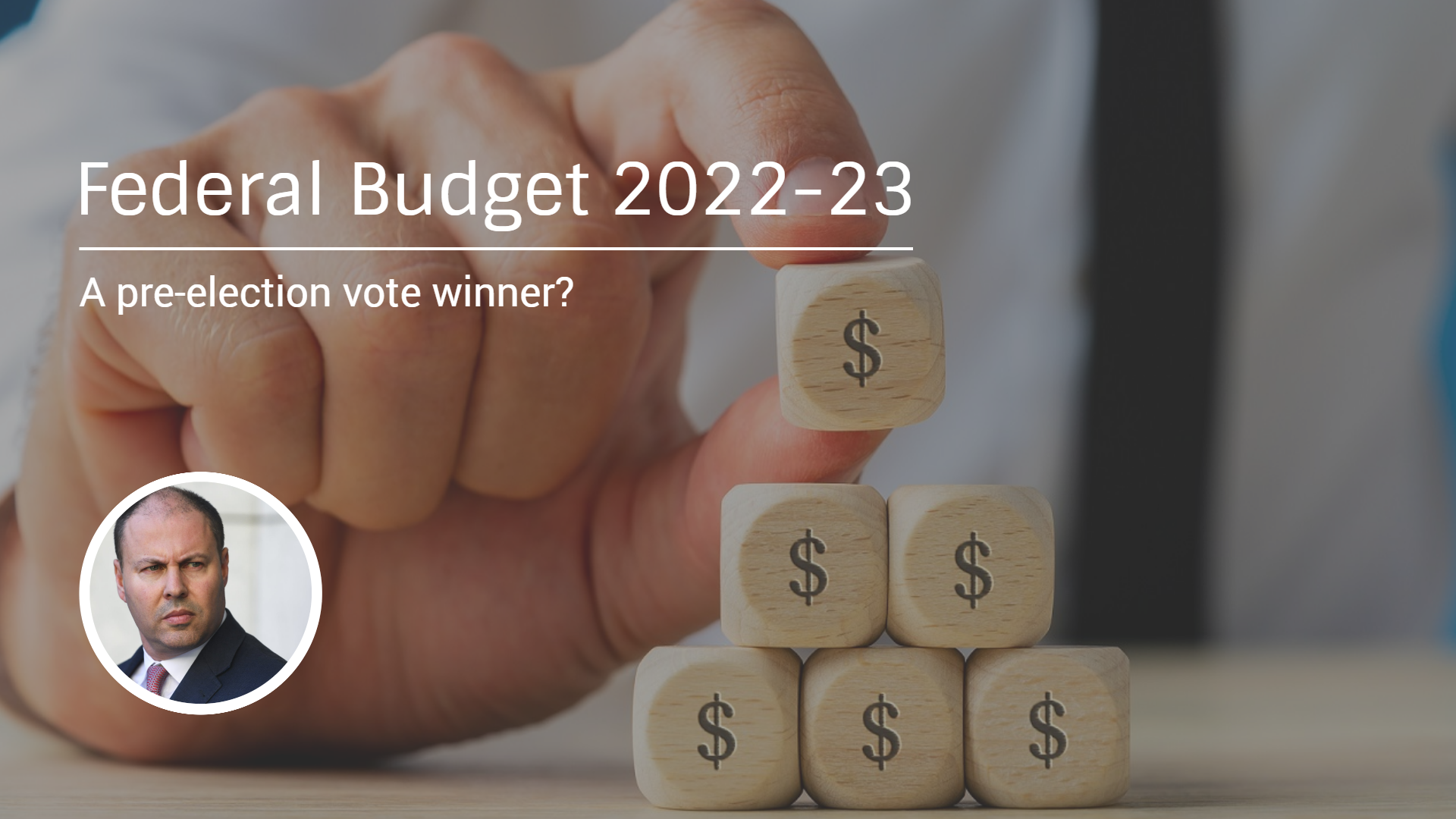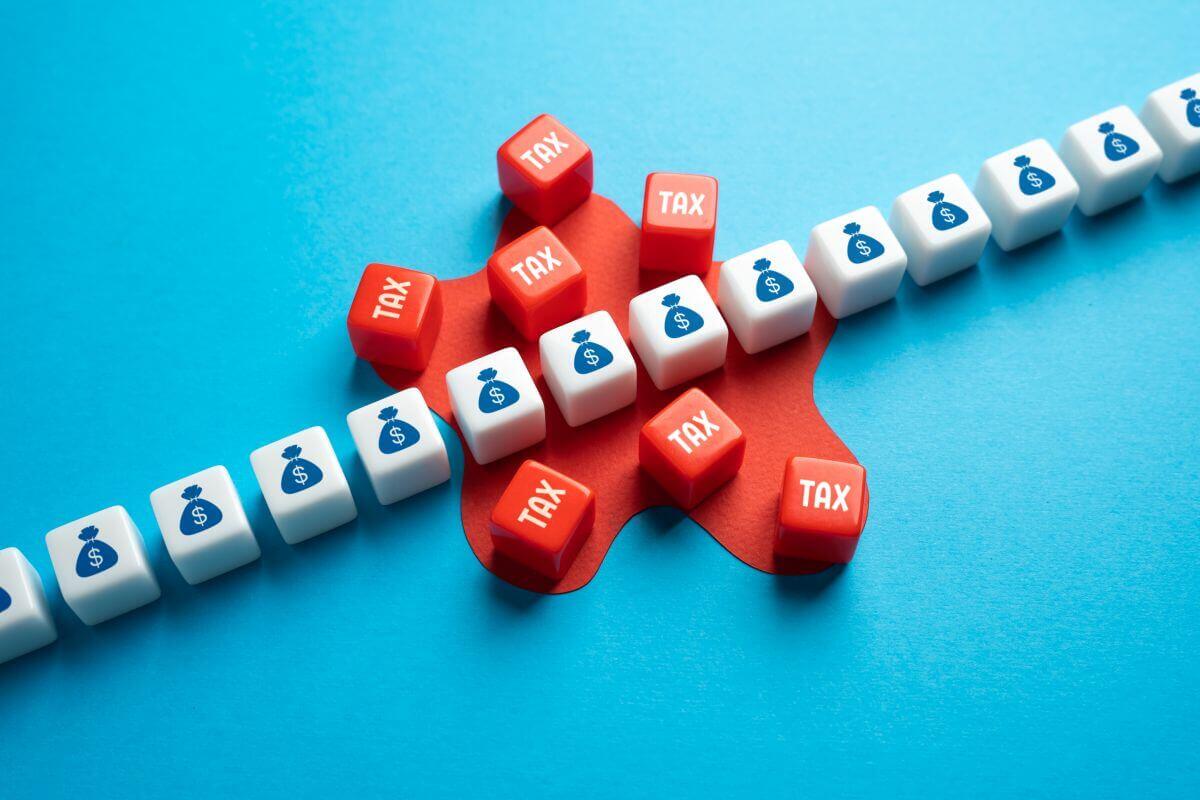Federal Budget 2022-2023 - A pre-election vote winner?
At 7.30pm on Tuesday March 29th, 2022, with a federal election likely to be called within a few months, Treasurer Josh Frydenberg delivered his fourth federal budget. The budget is based on the current and predicted economic and financial conditions and is being viewed as budget for ‘repair’ and one to address the rapidly rising cost of living and the skills shortage in the workforce.
As Australia moves on from the significant pandemic measures of the last two years and closed state and international borders, the expectation is for economic growth to reach 3.5% in 2022-23 (an upward revision from a year ago) and then slow to 2.5% in 2023-24.
- Along with higher-than-expected economic growth, unemployment is at its lowest rate since 1974 at 4% and is predicted to fall further to 3.75% over the next year. This is a dramatic reversal from the pandemic-based predictions of between 5.5% and 8%.
- Wage growth is also predicted to rise by 3% per annum in each of the next three years, although that growth will almost certainly be cancelled by rising prices.
- The country’s net deficit is expected to decline by $120 billion in 2022-23, from $835 billion to $715 billion. This will be driven by higher employment rates, lower welfare payments and increased revenues from resources.
Digital and Skills take centre stage
There is plenty in this year's budget for small to medium businesses (SMBs), from funding for a new small business unit within the Fair Work Commission to an extension of last year's patent box regime. It is the digital and skills focused initiatives that take top billing for the nation's employers.
As in the 2021-22 federal budget, the prediction is that the Australian economy is firing again on all cylinders and is recovering strongly from the impact of the pandemic. However, with surging inflation and a dramatic skills shortage, the budget aims to help businesses facing rising costs and a lack of qualified labour.
The Morrison government said they will be 'backing small business' and last night's federal budget outlines how it plans to do so.
What the Budget 2022-23 delivers...
1. Apprenticeship Incentive System & Apprenticeship Wage Subsidy extended
1.1 Apprenticeship Incentive System
- $2.8 billion for the new Apprenticeship Incentive System and employee retention.
- New apprentices will receive $5,000 in payments over two years, to train in key industries with skills shortages.
- There will also be wage subsidies for employers who take on trainees in priority industries.
1.2 Extension of Apprenticeship Wage Subsidy
-
The Boosting Apprenticeship Commencements wage subsidy will be extended to support businesses and Group Training Organisations that take on new apprentices and trainees. Eligible businesses will be reimbursed up to 50% of an apprentice or trainee’s wages of up to $7,000 per quarter for 12 months. The subsidy will be available to 30 June 2022.
[Source: Budget Paper No 2, p 76; Glossy “Australia’s plan for a stronger future - Overview”, p 46.]
2. Additional 20% of eligible expenditure for SMBs supporting Digital adoption
- Bonus tax deductions available for small businesses that invest in external training courses in IT and for eligible expenses for IT equipment (including cyber security) up to $100,000.
- Small and medium businesses (SMBs) will be able to deduct an additional 20% of eligible expenditure supporting digital adoption. The additional deduction will apply for businesses with aggregated turnover of less than $50 million.
-
Eligible expenditure will include the cost of depreciating assets and business expenses supporting digital adoption, such as portable payment devices, cyber security systems or subscriptions to cloud-based services. An annual cap of $100,000 will apply to expenditure eligible for the additional deduction. The measure will apply for eligible expenditure incurred from 29 March 2022 until 30 June 2023. Where eligible expenditure is incurred before 1 July 2022, the additional deduction will be claimed in the tax return for the following income year.
[Source: Budget Paper No 2, p 27.]
3. Patent Box Scheme
- The Patent Box scheme will expand to cover agriculture and lower emission innovations and will attract a concessional tax rate of 17%. Originally, income from Australian patents in medical and biotech were taxed at a concessional rate of 17% and this has now been rolled out to cover agricultural and climate-focused innovation in Australia.
4. Concessional tax treatment for carbon abatement and biodiversity stewardship income
-
Concessional tax treatment will apply from 1 July 2022 for primary producers selling Australian Carbon Credit Units (ACCUs) and biodiversity certificates.
- Proceeds from the sale of ACCUs and biodiversity certificates generated from on-farm activities will be treated as primary production income, providing access to existing income tax averaging arrangements and the Farm Management Deposits scheme. The taxing point of ACCUs for primary producers that are eligible for tax averaging or the Farm Management Deposits scheme will also be changed to the year in which they are sold. Similar treatment will be extended to biodiversity certificates issued under the Agriculture Biodiversity Stewardship Market scheme.
[Source: Budget Paper No 2, p 26.]
5. Continued access to unlisted company Employee Share Schemes (ESS)
-
For employers that make larger offers in connection with ESS in unlisted companies, participants can invest up to:
-
$30,000 per participant per year, accruable for unexercised options for up to 5 years, plus 70% of dividends and cash bonuses; or
-
any amount, if it would allow them to immediately take advantage of a planned sale or listing of the company to sell their purchased interests at a profit. Regulatory requirements for offers to independent contractors will be removed, where they do not have to pay for interests.
[Source: Budget Paper No 2, p 19.]

-
6. Pay-As-You-Go (PAYG) Tax Calculations
- Improvements to small business cash flow through a reduction from 10% to 2% in the GDP ‘uplift’ rate will be worth around $800 a year for 2.3 million small businesses through compliance savings and changes to the Pay-As-You-Go tax calculations.
-
The gross domestic product (GDP) uplift rate that applies to pay-as-you-go (PAYG) instalments and GST instalments will be set at 2% for the 2022–23 income year. The 2% uplift rate will apply to instalments for the 2022-23 income year that fall due after amending legislation receives assent. The current annual aggregated turnover thresholds for using the GST instalment method is $10 million and $50 million for PAYG instalments.
[Source: Budget Paper No 2, p 29.]
7. Additional funding to further reform insolvency arrangements
-
Additional funding will be provided to further reform insolvency arrangements. This includes:
-
$22 million to implement reforms to unfair preference rules, including enhancing the Assetless Administration Fund, from 1 July 2023
-
$7 million to clarify the treatment of trusts with corporate trustees under Australia’s insolvency laws; and
-
$0.8 million in 2022-23 to implement the government’s response to the recommendations of the Review of the insolvent trading safe harbour, released in March 2022.
[Source: Budget Paper No 2, p 171.]
-
8. Australia's business registry fees to be streamlined
- Fees associated with Australia's business registers will be streamlined over 3 years from 2023-24.
- Company registration and lifecycle management are scheduled to move to a modernised platform in September 2023. These reforms to Australia's business registers will:
- remove the companies annual late review fee
- reduce the number of fees paid for ad hoc lodgments under existing requirements
- remove fees for searches conducted on the new platform, and
- provide $300,000 to the Department of Treasury to redesign wholesale business register search services facilitated by third-party services.
[Source: Budget Paper No 2, p 6.]
9. LMITO & LITO
9.1 The Low and Middle Income Tax Offset (LMITO)
- The Low and Middle Income Tax Offset (LMITO) will increase by up to 1,500 for singe people and $3,000 for couples at tax filing time (as long as they earn less than $126,000 per year.
9.2 The Low Income Tax Offset (LITO)
- The Low Income Tax Offset (LITO) remains unchanged at $700 and will be reduced at a rate of:
- 5 cents per $1 for income between $37,500 and $45,000, and
- 1.5 cents per $1 for income between $45,000 and $66,667.
9.3 Effective tax-free threshold (2021-22) with LMITO and LITO
- $25,437 for individuals below Age Pension age (Please note that some Medicare levy may be payable).
10. Increasing the Medicare levy low-income thresholds
-
Low-income taxpayers will generally continue to be exempt from paying the Medicare levy.
-
The proposed effective date is 1 July 2021. The threshold for:
- Singles will be increased from $23,226 to $23,365
- Families will be increased from $39,167 to $39,402
- Single seniors and pensioners will be increased from $36,705 to $36,925
- Families (seniors and pensioners) will be increased from $51,094 to $51,401.
- For each dependent child or student, the family income thresholds increase by a further $3,619.
11. Superannuation minimum drawdown rates
- The halving of the superannuation minimum drawdown requirements for account-based pensions and similar products will be extended to 30 June 2023. The minimum drawdown requirements determine the minimum amount of a pension that a retiree must drawdown from their superannuation to qualify for tax concessions.
12. One Off Payment
- A one-off payment of $250 will be made to 6 million pensioners, carers, veterans, job seekers and some self-funded retirees.
13. Fuel Tax
- Fuel tax on petrol and diesel will be halved to 22 cents per litre on petrol and diesel for six months from March 30. The ACCC will ensure retailers pass on the full tax saving to consumers.
14. Education
- $2.2 billion program to commercialise university research and 30,000 more university places than last year.
15. Women
- $56 million funding will be provided to assist women to take on roles within the technology and manufacturing industries and further funding for entrepreneurial skill development will be available for women.
16. Parental Leave
- More flexibility in paid parental leave, as couples will be able to decide how they share the 20 weeks parental leave (18 weeks’ paid leave plus two weeks of Dad and Partner pay) and single people will be able to take the full 20 weeks themselves.
BUDGET CONCLUSION
In conclusion, the budget appears to be election focused with $8.6 billion of payments, tax cuts and cuts to fuel excise, which will potentially push back the reparation of the economy. It is yet to be seen whether this budget will address the two issues facing Australia in 2022, the rapid rise in the cost of living and the acute skill shortage.
Personal Tax rates, thresholds and offsets
|
Marginal tax |
Thresholds - income |
Thresholds - income range 2022-23 to 2023-24 ($) |
Thresholds - MTR* (%) and |
|
||
|
0 |
0 – 18,200 |
0 – 18,200 |
0% |
0 - 18,200 |
||
|
19 |
18,201 – 45,000 |
18,201 – 45,000 |
19% |
18,201 – 45,000 |
||
|
32.5 |
45,001 – 120,000 |
45,001 – 120,000 |
30% |
45,001 – 200,000 |
||
|
37 |
120,001 – 180,000 |
120,001 – 180,000 |
- |
|
||
|
45 |
> 180,000 |
> 180,000 |
45% |
> 200,000 |
||
|
LMITO |
Up to 1,500^ |
- |
- |
|
||
|
LITO |
Up to 700 |
Up to 700 |
Up to 700 |
|
||
*Excluding 2 per cent Medicare Levy
^ Including proposed increase of $420
This article is intended to provide general information only, and is not to be regarded as legal or financial advice. The content is based on current facts, circumstances, and assumptions, and its accuracy may be affected by changes in laws, regulations, or market conditions. Accordingly, neither Azure Group Pty Ltd nor any member or employee of Azure Group or associated entities, undertakes responsibility arising in any way whatsoever to any persons in respect of this alert or any error or omissions herein, arising through negligence or otherwise howsoever caused. Readers are advised to consult with qualified professionals for advice specific to their situation before taking any action.







Comment